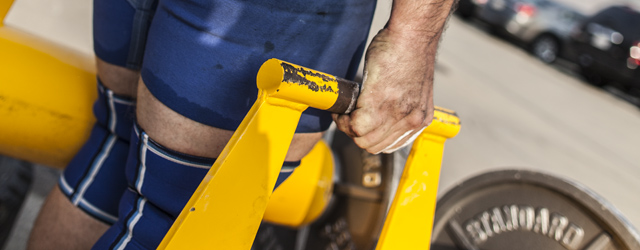
For every sport, there are certain key lifts that when performed by the athlete will tell you how well he or she will do in the sport. Once a predictor lift is improved, it will correlate with an improvement in performance.
Different sports have different predictor lifts. So a soccer player and a swimmer should not be tested the same. These lifts will tell you the optimal strength for the sport in relation to percentages of body weight.
For mixed martial arts (MMA) fighters and grappling competitors (jiu-jitsu, wrestling, judo), here are the predictor lifts that I think are important:
•Close grip incline bench press (grip should be about 12 inches from thumb to thumb)
• Medium parallel grip chin-up
• Back squat (the more you can back squat, the easier it is to throw someone)
Note: If you have the luxury of fat bars and fat grips, these would make the predictor lifts even better because of the strong grip element involved in the sport.
Grip strength with various grip tests
The relationship between grip strength and performance in judo and wrestling is high. The hands are the first thing that connects you to your opponent. The guys with the best grip often have the best performance.
You don’t necessarily have to do the predictor lifts to improve them. You can train supplemental exercises that target the muscles used in the key lifts. I’ve found that the best results happen if you change the accessory lifts every 2–4 weeks or once your poundage or reps aren’t going up. If you’re not training the predictor lifts directly, make sure you’re testing them every so often. I usually test my athletes every 4–6 weeks.
I use a lot of powerlifting methods for getting my MMA figthers and jiu-jitsu competitors strong. You probably have a limited amount of time to train and want/need the biggest return on your investment.
Here are some of the upper body lifts I use for driving up the predictor lifts:
• Floor presses (barbell or Swiss bar)
• 2- and 3-board presses
• Flat and incline presses with chains (barbell or Swiss bar)
• Flat presses with bands
When it comes to training the back, I’ve used every pull-up and chin-up known to man, but most of the time, I just have my athletes change their grip (pronated, supinated, parallel), width, and load (body weight or adding an external load such as a weight vest or dip belt with weights).
Here are some of the rows I use the most:
• One-arm dumbbell rows
• Bent over rows (supinated and pronated)
• Seated cable rows (all variations)
The pull-ups and chin-ups are used for both low reps and high reps. But the rows are almost always used for no less than six reps because going really heavy often becomes a circus act for most people. The majority of the time, the rows are for putting on muscle and the chin-ups and pull-ups are for increasing relative strength.
Almost all the athletes I train within the grappling sports have had injuries to the neck, shoulders, and thoracic spine (myself included), so assistance exercises to strengthen these areas are paramount. Typically, if I have an athlete who has problems with these areas, fixing them makes him stronger in the bigger lifts just like fixing the alignment of a car would make it go faster and drive better.
For the lower body, the main lifts I use to drive up the predictor lift (back or front squat) are:
• several squat variations
• several deadlift variations
The supplemental lifts used are:
• Standing and seated good mornings
• Romanian deadlifts (barbell and dumbbell)
• Back extensions
Grapplers need a lot of unilateral lower body training because of structural imbalances. Many of my athletes aren’t initially qualified for squats because of structural weaknesses. So the majority of the time, unilateral exercises are done first to correct these problems.
Here are a few I use often:
• Bulgarian split squats (dumbbell or barbell)
• Front foot elevated cable split squats
• Reverse Lunge Off Box
• Step-up (barbell or dumbbell; height dependent on what you’re targeting)
If you have the luxury of training with Strongman implements, here are a few more exercises I use a lot for legs:
• Sled drags (backward and forward; time and weight dependent on the training objective)
• Prowler push
• Tire flips








